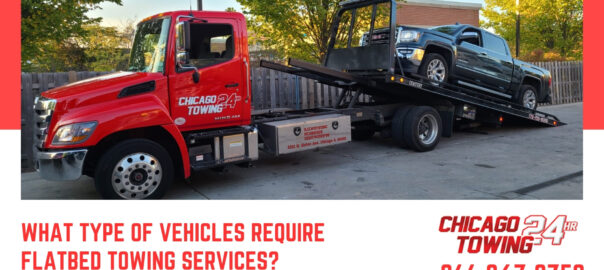In this blog entry, the professional Chicagoland towing service here at Towing Chicago will detail exactly what types of vehicles can be flat towed.
What exactly is flat towing?
Flat towing is towing a vehicle with all four wheels on the ground while connected to a tow vehicle with a tow bar. This is a common way that RV owners tow a smaller vehicle with them. Unlike trailer towing or dolly towing, flat towing doesn’t need additional equipment like a tow dolly or trailer. However, vehicles need to be specially designed or modified for safe towing in this way in order to avoid damage to transmission or drivetrain.
What are the benefits of flat towing?
- It is convenient, with no need to unload or load a vehicle onto a trailer
- It is cheaper than towing with an enclosed trailer
- There will be no need to store trailers or dollies at your destination
- They are easier to navigate than trailers, especially when driving in reverse
- They are lighter than trailer towing, which improves fuel economy
What types of vehicles can be flat towed?
- Manual transmission vehicles. The internal vehicle components will not be forced to rotate when the transmission is put in neutral
- Automatic transmissions that are specifically designed to allow for flat towing. Automatic transmission that are not, can lead transmission fluid to overheat which can cause damage
- Four wheel drive or rear wheel drive vehicles that can have drive shafts disconnected from transmissions
- Some front wheel drive vehicles, but most modern front wheel drive vehicles with automatic transmissions cannot be flat towed without special modifications
What vehicles cannot be flat towed?
- Most electric and hybrid vehicles
- Most CVT (Continuously Variable Transmission) vehicles
- Most front wheel drive vehicles with automatic transmissions
- Most all wheel drive vehicles without neutral modes
- Most luxury vehicles
- Vehicles with electronic parking brakes that cannot be kept in disengagement mode
How can I prepare my vehicle for flat towing?
- You will require a base plate kit that attaches to your vehicle frame, a tow bar to connect your vehicle to the RV, safety cables as a backup connection in the event of tow bar failure, a supplemental braking system, a wiring kit for turn signals and brake lights, and tow bar wiring to connect the lights of the towed vehicle to the R
What do I need to check before flat towing?
- Check your owner’s manual to determine if your vehicle is approved for flat towing
- Connect the tow bar and safety cables
- Follow all manufacturer specific transmission preparation procedures
- Make sure the steering wheel is secured and unlocked
- Check that all lights are functioning
- Check that the supplemental braking system is functioning
- Check tire pressure on all tires for both vehicles
What are some common flat towing mistakes?
- Ignoring owner’s manual
- Forgetting to put the vehicle in neutral
- Not disconnecting the vehicle battery
- Going faster than the speed limit
- Towing in reverse
- Not using a supplemental braking system
- Ignoring vehicle weight limits

